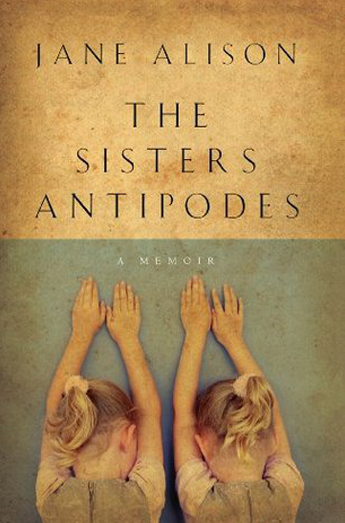 “An incomparable personal story exquisitely, stunningly told.” —Publishers Weekly (starred review)
“An incomparable personal story exquisitely, stunningly told.” —Publishers Weekly (starred review)
“Alison masterfully delineates the treacherous forms…jealousy…[can] take…in a truly unusual, harrowing journey of identity.” —Kirkus Reviews (starred review)
When Jane Alison was a child, her family met another that seemed like its mirror: a father in the Foreign Service, a beautiful mother, and two little girls, the younger two (one of them Jane) sharing a birthday. The families became inseparable almost instantly. Within months, however, affairs ignited between the adults, and before long the parents exchanged partners, then divorced, remarried, and moved on. Two pairs of girls were left in shock, a “silent, numb shock, like a crack inside stone, not enough to split it but inside, silently fissuring” that would prove tragic.
Reviews

People Pick of the Week
It could only have happened during the free-love ’60s: When Australian-born Jane Alison was 4, her diplomat dad and a friend’s father switched places, and families, after falling in love with each other’s wives. Amazingly, all four parents seemed to believe things would turn out fine. They didn’t. In this wrenching, luminous memoir, Alison explores the incalculable damage done: the fraught, shifting alliances; her guilt as both dads apparently favored her over her doppelganger stepsister; the crippling shadow her childhood still casts. “Girls who grow up without fathers are so full of longing,” a writing teacher tells her. Alison had two, but the longing has never died.

Double or Nothing
Jane Alison’s fairy tale-like memoir
“My family will not welcome this,” predicts Jane Alison about her fairy tale-like memoir, The Sisters Antipodes (Houghton Mifflin Harcourt), but her haunting story is one that truly compels telling. When Jane was four and her sister was six, their parents divorced in order to trade spouses with another couple who had two daughters about the same ages. Their fathers, diplomats stationed at various times in Australia and Washington, DC, switched households, setting off a ripple of identity crises in their offspring. “The absent presence of the other family was never mentioned but always felt,” Alison writes, “a sense of otherness elsewhere to which we were bound.” Although everyone pretended that “everything was fair and right, because everything was even,” all four daughters wound up feeling displaced, and the two youngest–Alison and her “counterpart,” Jenny– were the most grievously affected: “[Jenny] and I stood hip to hip, hurling darts at a bull’s eye until we’d nearly hurled away our arms, to see who was better, more clever, more able, really worth something, really should win, in fact should be the only one there because we could not both exist. What lay buried and mute was the panic that.my father seemed likely to slip out of reach while standing there. He might finally look at me but blink and see nothing. Or look at me but see only Jenny.” Alison’s writing is pointed and poignant, sprinkled with breathtaking intuitions–if also the odd overambitious metaphor. She spent so many years just figuring out how she belongs, and where, and to whom–and often with such tragic results–that her memoir seems less a breach of family ties than an act of bravery.

Girls, interrupted
Jane Alison recounts her and her stepsister’s conflicted history after their parents swap partners. With the insight of a novelist and the language of a poet, Jane Alison, author of "The Love-Artist," "The Marriage of the Sea," and "Natives and Exotics," begins her memoir, "The Sisters Antipodes," with the kind of shockeroo statement guaranteed to win the best-first-sentence award: "In 1965, when I was four, my parents met another couple, got along well, and within a few months traded partners." Ah, we deduce, tie-dye, free love, open marriage, incense, chants of "Om," all illustrating yet another laissez-faire tale of barefoot children running wild on a commune.
But Alison’s parents are hardly hippies. Her father is a diplomat from Australia, just back to Canberra from a job in Washington, D.C. The other couple are Americans returning to the States after a diplomatic posting in Canberra. In their early 30s, slim, well educated, good-looking with no rainbows or peace signs embroidered on their jeans – in fact, no jeans – they are such matched bookends that each couple’s younger girls, Jane and her mirror image, Jenny, share a birthday; the fathers’ birthdays are only weeks apart, as are both mothers’. “The two families had so much in common, people said: They must meet.”
It is a meeting – in Canberra – that for the grown-ups marks a beginning and for the children, particularly Jane and Jenny, signals the beginning of the end. Before the year is over, Jane and her mother and sister will follow the American, Paul, to Washington, and Jane’s father will remain in Canberra, this time with Helen in the master bed and Helen’s daughters at the dinner table. What Jane and Jenny couldn’t have predicted was that “for seven years we’ll shadow each other around the globe, that the split will form everything about us: that we will grow up as each other’s antipode . . . two bodies pressed together, foot to foot.” While the families are separated by continents, their points of connection paradoxically tighten. Two years after the split, a baby boy is born to each family, just four days apart. These births form a tangled cat’s cradle over the fissure and knit them together.
However tethered, neither family sees or speaks to the other for seven years. All communication arrives by letter, until 1973, when both groups land in the States: one family, still in Washington, the other now in New York City. While the reconfigured pairs settle down, both girls – stunned and shocked, displaced and replaced – struggle to find an identity notwithstanding “our parents’ split at our core, our tissues growing around it, around the fact that we’d each been replaced.”
If you’ve been replaced, if you lose your home, how do you establish a toehold in both geography and in a parent’s heart? Jane agonizes over her ferocious jealousy of Jenny and tries to ingratiate herself with Paul by being the smartest, cleverest, “fastest runner, best skater, funniest girl,” so that he will see “a little ally, a small consolation” for the daughters he’s lost. She’s thrilled when he tousles her hair, holds her hand, laughs at her jokes, pronounces her cute. Later, she obliterates such father-longings with promiscuous sex, drinking until she blacks out so she’ll only wake up when it’s over; and, after Paul leaves her mother, drinking so she can fill “the awful absent presence of Daddy and Paul.”
Despite what those in the helping professions would call acting out, Jane goes to Princeton, wins prizes, becomes an achiever. Jenny, on the other hand, spirals downward in a much more dramatic and blatant way. She seduces Jane’s boyfriend, drops out of school, cuts her wrists, gets raped, shoots heroin. Soon enough the two girls become less mirror images and more “Snow White, Rose Red.” Jane pulls herself back from the edge; Jenny falls into the black hole.
Although both girls are lost, why does Jenny tumble into blackness and Jane manage to “step back into the ordinary world with its ticking clocks and the body you’ll be trapped in until you die”? Throughout her narrative, Alison attempts to throw light on the blackness of loss. What is love, she wonders, and does it exist if a father can leave his daughter? Can the longed-for Australia of “a gum’s peeling bark, a kangaroo’s tail as it belts into the trees, the screams of a kookaburra hacking the air” still hold your roots when you’ve been yanked away from it? How does one compensate for such profound loss? After all, “to be from the ‘antipodes’ but to have lived on the other side of the world fixes home, the point of orientation, as perpetually elsewhere. The center is never where you are.” Such questions Alison examines from every single angle not just obsessively but excessively. No facet of this twinned, entwined family is left unexplored.
In an interview, Alison has said that she tried to write her family’s story as fiction and failed. Not surprising since, in a novel, such parallel incidences and reflecting characters might seem contrived and unbelievable. We novelists always tell our students that fiction needs a logic that real life doesn’t have. But who can dispute the details of a memoir? Especially one in which the extraordinary facts are sifted through a novelist’s unflinching eye. Jane Alison has taken the unbelievable and made it real.

(starred review)
The author was four and her sister Maggy seven in 1965, when their parents, Australian diplomat Edward and teacher Rosemary, had affairs with an American couple, Paul and Helen, who were in Canberra for Paul’s diplomatic post. The Americans had two girls almost the same ages, Patricia and Jenny. Within nine months, the families had realigned, with the fathers trading places. Jane and Maggy got a new father, new surname, new home across the Pacific and antipodal sisters who, in turn, inherited Edward as a father and the author’s beloved Australia as home. In rich, lyrical prose, steeped in classical imagery and vivid similes of the natural world, the author discusses the implications of this shock-inducing split. Along the way she covers her nomadic childhood in Washington, D.C., Los Angeles and South America and her precocious adolescence and meandering adulthood. Alison refrains from hiding behind linguistic dexterity, however, laying herself bare by including verbatim passages from her diaries. Rosemary endured a tempestuous marriage with Paul; the American was cold, though pretty, smart, fierce Jane finally earned his love long after Maggy had given up. After seven years of letters and increased fascination with the other family, Jane and Maggy finally saw their birth father, newly posted to New York, and spent time with Helen and her daughters. The encounter launched a long, destructive competition between Jane and her counterpart Jenny (they shared a birthday) for grades, races, boys and, above all, their fathers’ love. The author’s narration of these years painfully explores jealousy, home, memory and “the wretched human economics of desire and desirability.” Playful syntax and meaningful fragments arranged like poles around colons—“The heart of jealousy: knowing you’re dispensable”—pull the reader along in rhythmic, sensual currents of language that sparkle with Alison’s talent for tethering the abstract to physical description.
An incomparable personal story exquisitely, stunningly told.

(starred review)
In this enormously compelling memoir, novelist Alison (Natives and Exotics) recounts the strangely definitive reconfiguration of her family when her parents broke up and switched partners and children with another couple they met in Australia. In 1965, when Alison was four and her sister seven, they were living in Canberra, where her father was an Australian diplomat. The family met an American diplomat and his family with two daughters of similar ages–the youngest, Jenny, even shared the same birthday as Alison. The couples were fascinated with each other, and soon the marriages realigned: Alison and her sister moved in with their mother, Rosemary, an Australian teacher, and Paul, the American diplomat, who moved them back to the U.S.; Alison’s father, Edward, now married to Helen, became stepfather to her two daughters in Australia. During the seven years of Paul and Rosemary’s tenuous marriage, Alison, a plucky, boyish, observant child, set out to win Paul’s admiration by her accomplishments, and when she finally saw her biological father again in 1973, it became clear that Alison and her antipodal sister, Jenny, were each harboring the “mass of fantasy, jealousy, and longing that was crucial and would define us.” Alison masterfully delineates the treacherous forms this jealousy would take, especially amid the sexual self-abnegation of adolescence, in a truly unusual, harrowing journey of identity. (Mar.)

Caught in a real-life parent trap
REVIEW BY REBECCA STEINITZ
In 1965, in Canberra, an Australian diplomat and his wife became fast friends with an American diplomat and his wife. Within months, the couples had split and recombined, the men leaving not just their wives, but also their daughters (two apiece, the older ones the same age, the younger exactly a year apart, their birthday shared), for the women of the other family.
Novelist Jane Alison was the youngest of the four daughters, and The Sisters Antipodes is her stunning memoir of the enduring consequences of this familial rearrangement. Those consequences were particularly severe for her and her stepsister Jenny, whose same birthday and similar name were only the beginning of a long string of painful parallels. Endlessly competing for the love of their lost and shared fathers, seeking an ineffable sense of home in strings of diplomatic postings, the two girls struggled, together and apart, for decades.
In prose both lush and precise, Alison tries to piece together what happened. Intensely self-aware, she captures the confusion of a child dislocated from everything she knows save her mother and sister, the desire of a teenager for the bad boy who only appears in the dark, and the disjunction of a college student who wins Latin prizes by day and drinks herself into oblivion by night. She is also acutely observant of all that surrounds her, from mountains and insects, to houses and apartments around the world, to life as a teenager in 1970s Washington, D.C., with its summer soundtrack of cicadas and racial tensions in the public schools.
As she watches Jenny’s disintegration, Alison comes to understand that her perspective was not the only one, and that her parents—all four of them—tried to address the effects of their actions as best they could. Yet she does not settle for easy answers or rote forgiveness, remaining ever aware of the intransigent complexity of events and emotions. In the end, perhaps, the only conclusive outcome to her family’s story is this wise and beautiful book.
Rebecca Steinitz is a writer in Arlington, Massachusetts.

They f*** you up, your mum and dad
So you thought your parents were weird. Two remarkable memoirs about partner swapping, revolutionary politics and other unorthodox family tales.
By Andrew O’Hehir
March 31, 2009 | It has come to my attention, and very likely to yours, that everybody in the country, and quite possibly the world, has a story to tell about his or her screwed-up family background. My own story, which I will certainly tell you sometime, involves the Communist Party, a pornographic anecdote regarding J. Edgar Hoover, the accidental deaths of two of my grandparents, and a woman marrying the same man three times over the course of 50 years.
Even by the standards set by the rest of us, it must be granted that Saïd Sayrafiezadeh and Jane Alison have remarkable stories to tell. They are stories both familiar and strange. Both authors are children of 1960s-era family breakups, and nothing could be more ordinary than that. But in both cases the divorces emerged from their parents’ highly unconventional life choices. Sayrafiezadeh, author of “When Skateboards Will Be Free,” was the product of a failed marriage between an Iranian immigrant father and an American Jewish mother, which is almost enough drama for one life all by itself. Then there’s the fact that he spent most of his childhood and adolescence attached to the Socialist Workers Party, a Trotskyist fringe element of the American left. While the SWP experienced a brief boomlet of prestige and influence in the late Vietnam era, its principal mission throughout the Nixon and Reagan years involved convincing its ever-shrinking, ever-aging membership that it stood “at the vanguard of the class struggle.”
Jane Alison was raised in a globe-trotting diplomatic family, or rather in two different such families, as she conveys in the gotcha opening sentence of “The Sisters Antipodes”: “In 1965, when I was four, my parents met another couple, got along well, and within a few months traded partners.” This was in Canberra, the capital of Australia, where Alison and her sister were born. After this startling switcheroo, they abruptly moved to Washington with their mother and their new stepfather to become Americans. The other couple’s two American-born daughters went off to become Australians with their own mother and Alison’s father. So begins a torturous and complicated narrative of doubleness and disloyalty, spanning several continents, in which Alison haunts and is haunted by her seeming doppelgänger, a girl who shares her birthday and has almost the same name, a girl who is blond and pretty like her and who has stolen her father.

Review | The Sisters Antipodes
When two couples exchange partners, a daughter feels abandoned and unwanted, BY ELLEN KANNER
Despite its breezy beginning — ”In 1965, when I was four, my parents met another couple, got along well, and within a few months traded partners” — The Sisters Antipodes is not a British sex farce. It is Jane Alison’s singular, stranger-than-fiction memoir. Author of three novels and a professor in the University of Miami’s MFA creative-writing program, Alison has set the stakes high. She makes no pretense of fiction and instead tries to present the truth of an almost unfathomable past.
She opens the book with a cool presentation of two mirror-image families. The men were diplomats with attractive wives and two daughters. Alison, the younger daughter of one family, found a twin in Jenny, the younger daughter of the other. The girls, like their parents, delighted in their sameness; both were bright, eager and blonde. They even shared a birthday, though Alison was a year younger.
But the girls barely got to enjoy each other before they were torn apart. Their parents divorced, exchanged partners, remarried and moved to separate sides of the world. Alison and Jenny ‘grew up with our parents’ split at our core, our tissues growing around it, around the fact that we’d each been replaced.”
That tissue did not scar over. As much as Alison tried to shut down emotionally, to ”turn to stone,” she suffered from abandonment, worthlessness and a lack of identity. So did Jenny. They believed ”we were replaceable, the currencies were liquid.” These feelings continued to seep and fester beneath the blithe facade they created, a facade their parents naively — or thoughtlessly — fostered, to ‘brush hands clean and smile and shake and say, `See, then, no harm done!’ ”
The brisk manner Alison uses at the start of the book quickly gives way to an emotional pain so primal she can only now give it voice. She felt a desperate rage and jealousy toward Jenny. ”I had to outdo her.” Even as she vied for the father with whom she no longer lived, she grew desperate to please her stepfather. ”If you said something clever he might lift a brow and take interest,” she writes. “And that current of interest was the start of everything, the current that lit me to life.”
Alison bounced from her birthplace of Canberra, Australia, to Washington, D.C., and Quito, Ecuador, wherever her stepfather was posted. As an adult, she lived in New Orleans, Miami Beach, Italy, Germany but always felt the pull and power of her other family and Jenny, her other self, living somewhere else. The feeling was nothing Alison could outrun or even outwrite, though perhaps subconsciously she tried. In a 2003 novel The Marriage of the Sea, Allison’s characters in New Orleans and Venice are preternaturally connected, despite the ocean between them. In Natives and Exotics, young Alice, whose name is almost the author’s, is uprooted from her home when her diplomat father is posted in Ecuador. For Alison, home will always be elusive, shape-shifting, that hard-to-define “intersection of blood and place.”
A former New Times editor, Alison opts not for analysis, accusation or even strict chronology but for a visceral telling. ”You remember deeply a moment or the tone of the day, how it burned your skin or stabbed into your ribs,” she writes. ”Yet at the time you say nothing, not even to yourself, so it exists without words and is like an animal dwelling mute in your tissues.” She richly describes how something feels down to its cellular level, but when relating Jenny’s penchant for self-destruction or her own, Alison often resorts to the dry, detached tone she uses at the beginning. She dispassionately relates her compulsive drinking and countless ”little black-out affairs.” And yet compared to Jenny, Alison is the lucky one.
The Sisters Antipodes is often beautiful and always brave, but despite Alison’s candor and considerable gifts, there is no happy ending. The author and her frayed and badly patched family ”are all worn out with this impossible story, we just try to get along.” If these events make for a somewhat unsatisfying conclusion to an otherwise haunting memoir, they must also make for an unsatisfying life.
Ellen Kanner is a writer in Miami.

It is very easy for memoirs and biographies to become a list of "and thens". For example – "I was born in Sydney and then I went to school and then I moved to Brisbane and then…", ad nauseum.
So cautious readers approach memoirs with some trepidation.
But in the case of Jane Alison’s haunting narrative of her troubled and complex family, no such reservations are necessary.
Instead of plodding chronologically through her life, she loops around and doubles back, weaving in and out of themes of identity, belonging and dislocation with a novelist’s skill and a surgeon’s precision.
She has a way of rendering the extraordinary in lucid, elegant tones. The first sentence of the book reads: "In 1965, when I was four, my parents met another couple, got along well, and before long traded partners.
The simplicity of the writing belies the terrible hurt and pain that this event triggered, some of it on a very slow burn, in the hearts of two families.
Born in Australia, Jane was the second of two girls to a diplomat father and a beautiful mother. The other family were American, but otherwise the same – in the foreign service, two little girls. The youngest ones (Jane and Jenny) even shared a birthday. They were each other’s antipodes – two bodies pressed together.
After the divorces, the remarrying, the moving half-way round the world, Jane and Jenny settled down to growing up with each other’s fathers, and to a competition for the men’s affections that was as destructive as it was unspoken.
Compelling, poignant and exquisitely put, The Sisters Antipodes is full of the kinds of insights that will linger far longer than the story itself.

To say Jane Alison and Jenny Stuart have much in common would be an understatement. During the 1960s and ’70s, for instance, both their fathers were diplomats, the first Australian, the second American.
“Both men were in their early thirties, tall, slim, and ambitious,” Alison writes in “The Sisters Antipodes.” “(Their wives) were smart and good-looking. Both couples had two little girls the same ages, and the younger girls shared a birthday and almost the same name.”
A few months after their families meet, the men and women trade partners. They divorce and remarry. Their daughters become stepsisters.
In this affecting and profound memoir, Alison looks at the ways in which her life and Stuart’s life converge from the beginning. With a gift for language and imagery, she describes their peculiar situation and the confusion they undoubtedly experienced growing up. She attempts to make sense of it.
When Alison’s mother marries Stuart’s father, Paul, and when her father marries Stuart’s mother, Helen, things change all around for everybody. People, places and labels shift.
Four-year-old Jane and her sister, Maggy, move with their mother and Paul to Washington, D.C., Los Angeles and South America. Five-year-old Jenny and her sister, Patricia, move with their mother and Alison’s father to Asia, the Middle East and New York City. Daughters and fathers stay in touch through correspondence.
“We called our father Daddy in our letters,” Alison explains, “but didn’t say the word much. The girls also called our father Daddy, while their own father they called Father. We called their father Paul. The girls were called the girls, or Paul’s girls, his real girls.”
Two years after the split, each couple has a boy, coincidentally, “babies that consolidated the new marriages and knotted us tighter. Tommy bound Maggy and me by blood to Paul and the girls, and bound the girls to our mother; Nicholas bound us even more to the girls as well as to Helen, and bound the girls to Daddy. Like paper dolls all holding hands.”
The parallels are uncanny, almost eerie. Contrasts between their lives, however, are inevitable, too.
Alison, for example, cannot help but wonder how good the other girls might have it. On a visit to New York when she is 11 and Maggy 14, they go with Helen to the Met, the Frick and the Guggenheim. They eat eclairs and Napoleons in neighborhood cafes. They never get to do these kinds of things, Alison notes, with their own mother.
She cannot shake feelings of abandonment either. How could a father, any father, she asks, leave his girls for someone else’s? Have she and Maggy been so easily and conveniently replaced by Stuart and Patricia? What is it about him, or them? At the same time, she must work hard to win her stepfather Paul’s full affection.
The questions and struggles define much of Alison’s childhood and stay with her for decades to come. They influence the ways in which she views herself as well as the relationships she develops with other men; guys in high school, for instance, and in college. These issues would have a significant impact, she eventually realizes, on Stuart, too.
With remarkable grace and insight, the author examines early upheavals and unfortunate tensions in her most unusual upbringing. She makes “The Sisters Antipodes” a thoroughly compelling and successful read.

Two memoirs at opposite poles
One, potentially fascinating, is slick and shallow. The other is profoundly moving
Going to Beijing for the first time? You might want to pick up Jan Wong’s A Comrade Lost and Found, a snappy travelogue packaged as a memoir.
Wong is a journalist and third-generation Canadian, the granddaughter of a “coolie” who worked on the Canadian Pacific Railroad. In 1972, disgusted with post-Kent State America and “in love with socialism,” she became one of only two Western students at Beijing University.
During her year there, a Chinese student named Yin had the bad judgment to ask Wong how she might get to study in the United States. The then-20-year-old “Montreal Maoist,” as Wong calls herself, dutifully informed a professor of Yin’s question. Yin was expelled from the university; no one knew what happened to her after that. Wong returned to Montreal, graduated from McGill University, and returned to Beijing in the ’80s and ’90s to work for the New York Times and the Toronto Globe and Mail.
Wong wondered about Yin from time to time, fantasizing that she was suffering somewhere in rural China or, alternatively, had managed to get out and was living happily in Las Vegas. But she didn’t take action until 2006, when she was 53. With her husband and two teenage sons in tow, Wong set out “to find Yin, apologize and try to make amends.”
This is a potentially fascinating story. Fifty years after Sen. Joseph R. McCarthy’s rise and fall, Americans are still debating the ethics and consequences of “naming names.” Cultures on every continent are struggling to address that legacy and reconcile betrayers and those betrayed under a long list of political regimes.
What happens to individual and collective memory in the aftermath of such psychic trauma? How do today’s Chinese look back on Mao Tse-tung’s Cultural Revolution? And how does Wong make sense of her own story – that, although she was “haunted” by “snitching” on Yin as a college student, she didn’t feel compelled to investigate her fate, despite repeated stays in Beijing as a reporter, until she was past 50?
These are just some of the questions that Wong does not answer in her slick, entertaining, and relentlessly flippant guide to Beijing, filled with thumbnail sketches of old comrades now nouveaux riches, their career trajectories, cars, residences, and new neighborhoods. She has four weeks to find Yin among them: Will she or won’t she? And what will happen when she does?
I won’t spoil the ending – just let you know that, though some of the stories Wong tells are funny and some are appalling, her writing is so breezy that it’s hard to care about any of the characters we meet. Beijing and its people, in Wong’s rendition, become a sitcom. We never get beneath the spanking-new surface of things.
Jane Alison’s The Sisters Antipodes, on the other hand, is so deeply felt and profoundly moving a memoir that one puts it down feeling emotionally bruised.
Alison’s writing is so spare and powerful that rather than summarize her story, I quote her opening paragraph: “In 1965, when I was four, my parents met another couple, got along well, and within a few months traded partners. This was in Canberra, where my father, an Australian diplomat, had just brought us home from a posting in Washington. The other couple were American but diplomats too. . . . Both men were in their early thirties, tall, slim and ambitious; both the women were smart and good-looking. Both couples had two little girls the same ages, and the younger girls shared a birthday and almost the same name. This was my counterpart, Jenny, and me.”
The realignment is complete within nine months. Then the American father is posted back to the United States and Jane is 4 when her Australian mother bundles up her daughters and follows him to Washington, D.C. Seven years of letter-writing pass before the Australian father is posted to New York, seven years during which the four “girls” neither see their biological fathers nor hear their voices. “I do not know why,” Alison writes. “Because it was expensive and no one made such calls in those days, or no one thought of it, or maybe because a live line between the two households seemed dangerous, fire.”
As the fathers are posted around the globe, taking their new families with them, Alison describes their circumstances and details the continuing, devastating consequences of loss – loss of father, name, country, accent, culture – especially for the two younger antipodes, as she calls herself and Jenny. Once placed in a bathtub together, foot-to-foot, they grow into fierce rivals on opposite sides of the globe. She links their cutthroat competitiveness and shaky sense of self-worth to “the fact that we’d each been replaced.”
This is a fascinating story from an author gifted, brave, and resilient enough to pursue its literary and psychological depths. Jane Allison writes that she tried for years to turn her family story into a novel but repeatedly failed.
Instead, she has written a groundbreaking, stellar memoir.

And then one day the world turned upside down
AFTER Alice plunged into the earth in pursuit of the White Rabbit, the tunnel “dipped suddenly down” and she began to fall, a fall that seemed likely to end in “The Antipathies”, she thought, where “people walk with their heads downwards”. Although Alice in Wonderland and Through the Looking Glass are not mentioned specifically in this memoir, there are many oblique references borrowed from Alice’s adventures to show how, in 1965, the writer’s life was turned upside down.
Sometime that year, she tells us, at a party in Canberra, “my parents met another couple, got along well, and before long traded partners”.
“In their early 30s, tall, slim and ambitious”, both men were diplomats, representing the US and Australia. Both women were beautiful in different ways. Both couples had two daughters the same age. The two younger girls, Jane and Jenny, even shared a birthday.
Begun in the tinkling salons of the capital city, the affairs played out on plaid picnic rugs “in glades of eucalypts”, the girls sent off after lunch to find koalas or kangaroos. (That old gum nut.) In the evening, four-year-old Jane would share a bath with five-year-old Jenny, their feet “pressed together and pushing”, the literal meaning, as it happens, of antipodes.
It was during one such session, Jane’s mother told her, that she “stood from sudsing us … stepped to the door, and saw, in the dimness of the next room, my father and Helen embrace”. This information comes at the end of the book and until then the reader, and maybe the writer, are unsure who “did it first”.
It was not long after this incident that, according to Jane’s mother, her husband gave her an ultimatum: “She must file for divorce or he would, because he wanted that woman.”
“There it all is,” notes Alison, “in that raw verb ‘want’.” And that is what this book demonstrates best, the catastrophic consequences of wanting and choosing, the primal indicators of personal worth.
It was decided “after less than nine months” that Jane and her sister, Maggy, would go to live in the US with their mother and Paul, the American diplomat. Jenny and her sister Patricia would stay in Australia with their mother, Helen, and Jane’s father, Edward. Such “miraculous neatness”.
And so dangerous, especially for Jane and Jenny, accidentally twinned, and from then on locked in a battle for ascendancy that would go down to the razor wire.
As much a soliloquy and an elegy as a memoir, The Sisters Antipodes explores painfully the reality and surreality of a child’s divorce. “These things happen: …” remembers Alison, and the grim colon absolves the cliche.
“A father vanishes overnight and turns into paper. Another man appears, his face rough and smelling of cigarettes and scotch when we kiss him, but he’s not ours, this is understood, he belongs to a pair of girls somewhere else.” His “real girls”, girls “we cannot see but this new nonfather sees each time he looks at us”.
Rendered invisible, Alison strives successfully to impress Paul. In turmoil she nevertheless graduates with honours from Princeton, having known intimately a significant proportion of the male student body.
On the other side of the world, Jenny is keeping pace with sex, drugs and blackouts. In a tower above an official Australian residence in Italy, Helen attempts to talk about “all this”. Alison has likened Helen’s personality to the shifting highlights in moire silk, her chilling put-downs masked by “another lovely della Francesca smile”.
On this occasion she addresses Alison’s “perfectly natural” jealousy of her and asks if she could “possibly imagine how hard it had been for her girls to lose their father”. In a notebook Alison comments: “The lack of shame disturbs me.” In a novel she calls herself Alice and tries “writing out this family”, “this impossible story”. Her experience in the tower merges in her mind with the time she nearly drowned, dragging down her rescuer, and she sees Helen and her father as “a pair of people so desperate in the water that they must push down any head to stay up”.
Apart from eliciting her mother’s “few fixed memories”, the writer did not consult her four parents about the split of 1965, the chain of events that sprang from “a single crime” and, like classical myth, brought down “the family, the house”.
An admirer of Lucretius, the Roman philosopher, she has, however, come to appreciate his theory that “life begins” only after one atom collides with another, disrupting the “eternal and lifeless” and creating new, “marvellously tangled” possibilities.
“You need entanglements,” says the writer, who has pitched the tenor of her book somewhere between the intellectual and the gut-wrenching, the damning and the forgiving. Alison the little girl lost a father and a fatherland and everything implicit in this. Alison the woman found and acquired other things, among them knowledge and wisdom. But, decades on, neither can explain “what made these four do what they did”, and this is, essentially and tragically, the cry of a child.
Kathy Hunt is a critic based in rural Victoria.